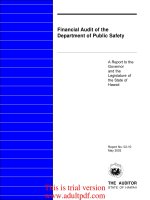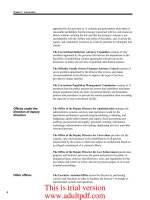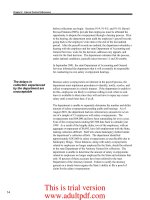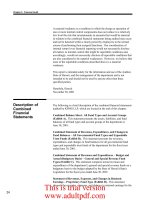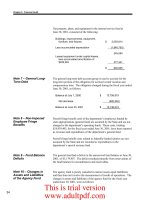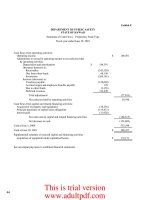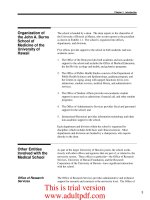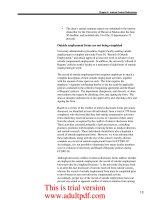Financial Audit of the John A. Burns School of Medicine of the University of Hawaii_part3 doc
Bạn đang xem bản rút gọn của tài liệu. Xem và tải ngay bản đầy đủ của tài liệu tại đây (39.17 KB, 10 trang )
13
Chapter 2: Internal Control Deficiencies
• The dean’s annual summary report was submitted to the interim
chancellor for the University of Hawaii at Manoa after the June
30 deadline, and included only 24 of the 33 departments (73
percent).
Outside employment forms are not being completed
University administrative procedures require faculty seeking outside
employment to complete university Form 50, “Record of Outside
Employment,” and obtain approval at least one week in advance of any
outside compensated employment. In addition, the university’s Board of
Regents’ policies restrict faculty to a maximum of eight hours of outside
employment per week.
The record of outside employment form requires employees to attach a
complete description of their outside employment activities, together
with the amount of time spent on each. The form requires the
employee’s signature confirming that he or she has read the applicable
policies contained in the collective bargaining agreement and the Board
of Regents’ policies. The department chairperson, unit director, or dean
must endorse the request by checking a box and signing the form. The
dean or designee indicates his or her approval by also checking a box and
signing the form.
Based on a review of the conflict of interest disclosure forms previously
discussed, we identified at least 48 individuals, from a total of 370 forms
completed, who disclosed that they had outside remunerative activities
from which they received income in excess of 1 percent of their salary
from the school, as required by the conflict of interest disclosure form.
These activities consisted primarily of private practices, consulting
practices, positions with hospitals or nursing homes as medical directors,
and outside research. These individuals should have also completed a
record of outside employment form. However, we were informed that
these individuals, along with the rest of the school’s faculty, did not
complete any record of outside employment forms for FY2001-02.
Accordingly, it is not possible to determine how many faculty members
were in violation of university and Board of Regents' policies during
FY2001-02.
Although university conflict of interest disclosure forms address whether
an employee has outside employment, the record of outside employment
form must also be completed because: 1) the university disclosure form
is an after-the-fact disclosure of income received from outside sources,
whereas the record of outside employment form must be completed prior
to involvement in any non-university compensated activity.
Accordingly, proper use of the record of outside employment form can
prevent any actual or apparent conflict of interest situation from arising;
This is trial version
www.adultpdf.com
14
Chapter 2: Internal Control Deficiencies
and 2) the disclosure form shows only the name and nature of the
organization from which an employee received compensation. It does
not indicate the nature of the outside activity or time spent on such
activity. (Although university policies state that the department head
may request additional information regarding outside activities, we did
not see any evidence that such was requested.) Thus, the disclosure form
alone does not provide sufficient information to determine whether time
spent on an outside activity exceeds the allowable limit or whether it
interferes with an employee’s primary obligation to the school.
We found a lack of compliance and enforcement of policies and
procedures at all levels within the school, from faculty and staff to upper
management, including the dean. Our discussion with the school’s
administration indicated that those officials were aware of the disclosure
form and outside employment form requirements, but did not enforce
compliance with the same. For example, we examined correspondence
from the school’s administration to applicable supervisors providing
detailed guidelines on completion of the forms. However, the school’s
administration had not followed up on uncompleted or late forms until
after we had requested access to the forms on file.
The school’s administration does not take seriously the consequences of
failing to disclose a conflict of interest situation. A university executive
policy states that failure to disclose a potential conflict of interest “is a
violation of university policy, can result in charges of scientific
misconduct, and may result in administrative or other sanctions as
appropriate, including the suspension of funding.” Because the
requirement for submitting disclosure forms and outside employment
forms is not enforced, a conflict of interest situation that interferes with
an employee’s obligation to the school may not be identified or
adequately resolved. Failure to monitor or control conflict of interest
situations could potentially lead to employees spending too much time
supplementing their income with outside activities at the expense of their
responsibilities to the school. In cases where research is funded by non-
university sources, the sponsor may even sanction the university, if
appropriate, because of a conflict of interest.
The school should take more seriously the consequences of not
identifying conflict of interest situations on a timely basis and enforce
policies, procedures, and deadlines for completion and submission of the
annual disclosure forms and outside employment forms.
Adherence to
university’s policies
and procedures is not
enforced by school
administration
Recommendation
This is trial version
www.adultpdf.com
15
Chapter 3: Financial Audit
Chapter 3
Financial Audit
This chapter presents the results of the financial audit of the John A.
Burns School of Medicine of the University of Hawaii, as of and for the
fiscal year ended June 30, 2002. This chapter includes the independent
auditors’ report and the report on compliance and internal control over
financial reporting based on an audit of financial statements performed in
accordance with Government Auditing Standards as they relate to the
school. It also displays the school’s financial statements together with
explanatory notes.
In the opinion of Deloitte & Touche LLP, based on their audit, the
financial statements present fairly, in all material respects, the financial
position of the school as of June 30, 2002, and the changes in its
financial position and its cash flows for the year then ended in
conformity with accounting principles generally accepted in the United
States of America. Deloitte & Touche LLP noted that the school has not
presented the management’s discussion and analysis information that the
Government Accounting Standards Board has determined is necessary to
supplement, although not required to be part of, the basic financial
statements. Deloitte & Touche LLP also noted that the results of its tests
disclosed no instances of noncompliance that are required to be reported
under Government Auditing Standards.
The Auditor
State of Hawaii:
We have audited the statement of net assets of the John A. Burns School
of Medicine of the University of Hawaii (school) as of June 30, 2002,
and the related statements of revenues, expenses, and changes in net
assets and of cash flows for the year then ended. These financial
statements are the responsibility of the school’s management. Our
responsibility is to express an opinion on these financial statements
based on our audit.
We conducted our audit in accordance with auditing standards generally
accepted in the United States of America and the standards applicable to
financial audits contained in Government Auditing Standards, issued by
the Comptroller General of the United States. Those standards require
that we plan and perform the audit to obtain reasonable assurance about
Summary of
Findings
Independent
Auditors’ Report
This is trial version
www.adultpdf.com
16
Chapter 3: Financial Audit
whether the financial statements are free of material misstatement. An
audit includes examining, on a test basis, evidence supporting the
amounts and disclosures in the financial statements. An audit also
includes assessing the accounting principles used and the significant
estimates made by management, as well as evaluating the overall
financial statement presentation. We believe that our audit provides a
reasonable basis for our opinion.
As discussed in Note 1, the financial statements of the school are
intended to present the financial position, and the changes in financial
position and cash flows of only that portion of the activities of the
University of Hawaii that are attributable to the transactions of the
school. They do not purport to, and accordingly do not, present fairly the
financial position of the University of Hawaii as of June 30, 2002, and
the changes in its financial position and its cash flows for the year then
ended in conformity with accounting principles generally accepted in the
United States of America.
In our opinion, the financial statements referred to above present fairly,
in all material respects, the financial position of the school as of June 30,
2002, and the changes in its financial position and its cash flows for the
year then ended in conformity with accounting principles generally
accepted in the United States of America.
As discussed in Note 1 to the financial statements, the school has
implemented a new financial reporting model, as required by the
provisions of the Governmental Accounting Standards Board Statement
No. 34, Basic Financial Statements—and Management’s Discussion and
Analysis—for State and Local Governments, and Governmental
Accounting Standards Board Statement No. 35, Basic Financial
Statements—and Management’s Discussion and Analysis—for Public
Colleges and Universities, as of June 30, 2002.
The school has not presented the management’s discussion and analysis
information that the Governmental Accounting Standards Board has
determined is necessary to supplement, although not required to be part
of, the basic financial statements.
In accordance with Government Auditing Standards, we have also issued
our report dated October 28, 2002 on our consideration of the school’s
internal control over financial reporting and our tests of its compliance
with certain provisions of laws, regulations, contracts, and grants. That
report is an integral part of an audit performed in accordance with
Government Auditing Standards and should be read in conjunction with
this report in considering the results of our audit.
This is trial version
www.adultpdf.com
17
Chapter 3: Financial Audit
/s/Deloitte & Touche LLP
Honolulu, Hawaii
October 28, 2002
The Auditor
State of Hawaii:
We have audited the financial statements of the John A. Burns School of
Medicine of the University of Hawaii (school) as of and for the year
ended June 30, 2002, and have issued our report thereon dated October
28, 2002. We conducted our audit in accordance with auditing standards
generally accepted in the United States of America and the standards
applicable to financial audits contained in Government Auditing
Standards, issued by the Comptroller General of the United States.
Compliance
As part of obtaining a reasonable assurance about whether the school’s
financial statements are free of material misstatement, we performed
tests of its compliance with certain provisions of laws, regulations,
contracts, and grants, noncompliance with which could have a direct and
material effect on the determination of financial statement amounts.
However, providing an opinion on compliance with those provisions was
not an objective of our audit and accordingly, we do not express such an
opinion. The results of our tests disclosed no instances of
noncompliance that are required to be reported under Government
Auditing Standards.
Internal Control Over Financial Reporting
In planning and performing our audit, we considered the school’s
internal control over financial reporting in order to determine our
auditing procedures for the purpose of expressing our opinion on the
financial statements and not to provide assurance on the internal control
over financial reporting. Our consideration of the internal control over
financial reporting would not necessarily disclose all matters in the
internal control over financial reporting that might be material
weaknesses. A material weakness is a condition in which the design or
operation of one or more of the internal control components does not
reduce to a relatively low level the risk that misstatements in amounts
that would be material in relation to the financial statements being
audited may occur and not be detected within a timely period by
Report on
Compliance and
on Internal Control
Over Financial
Reporting Based
on an Audit of
Financial
Statements
Performed in
Accordance with
Government
Auditing
Standards
This is trial version
www.adultpdf.com
18
Chapter 3: Financial Audit
employees in the normal course of performing their assigned functions.
We noted no matters involving the internal control over financial
reporting and its operation that we consider to be material weaknesses.
This report is intended solely for the information and use of the Auditor,
State of Hawaii, and the management of the school and is not intended to
be and should not be used by anyone other than these specified parties.
/s/Deloitte & Touche LLP
Honolulu, Hawaii
October 28, 2002
The following is a brief description of the financial statements audited by
Deloitte & Touche LLP, which are presented at the end of this chapter.
This statement presents the assets, liabilities, and net assets of the school
at June 30, 2002.
This statement presents the revenues, expenses, and changes in net assets
for the school for the year ended June 30, 2002.
This statement presents the cash flows from operating, non-capital
financing, capital and related financing, and investing activities of the
school for the year ended June 30, 2002.
Explanatory notes that are pertinent to an understanding of the financial
statements and financial condition of the school are discussed in this
section.
General
The John A. Burns School of Medicine of the University of Hawaii
(school) was established in 1965 originally as a two-year medical school
with two primary objectives:
• To provide opportunities for Hawaii’s citizens to have access to
careers in medicine equivalent to those available in other states;
and
Description of
Financial
Statements
Statement of Net
Assets (Exhibit 3.1)
Statement of
Revenues, Expenses,
and Changes in Net
Assets (Exhibit 3.2)
Statement of Cash
Flows (Exhibit 3.3)
Notes to Financial
Statements
Note 1 - Summary of
Significant Accounting
Policies
This is trial version
www.adultpdf.com
19
Chapter 3: Financial Audit
• To add to the stature, academic quality, and research potential of
the University of Hawaii (university).
The school converted to a four-year M.D. degree-granting institution and
graduated its first class in 1975. The school’s major emphasis is to train
students to a high level of competence as physicians for the state and
region and to conduct cutting-edge biomedical research, with the goal of
improving health care in Hawaii and the Pacific area. The school offers
an innovative and progressive problem-based curriculum, called the
“M.D. Program,” which is designed to integrate relevant basic science
with clinical material using actual cases.
The school operates administratively as a unit of the university’s Manoa
campus. The school is a community-based medical school that does not
own its own teaching hospital, but bases its clinical instruction in
affiliated community hospitals and clinics across the state of Hawaii.
Financial Reporting Entity and Basis of Presentation
Under the provisions of Governmental Accounting Standards Board
(GASB) Statement No. 14, The Financial Reporting Entity, the
university is considered a component unit of the State of Hawaii, its
primary government, and is included in the state’s basic financial
statements. However, the university is also its own reporting entity in
accordance with GASB Statement No. 14, and has determined that the
Research Corporation of the University of Hawaii (RCUH) and the
University of Hawaii Foundation (foundation) are its component units,
included in the university’s financial statements. The basic criterion for
determining whether a potential component unit should be reported
within a reporting entity is financial accountability. Other criteria,
including fiscal dependency and the nature and significance of the
relationship, are such that exclusion would cause the financial statements
to be misleading.
GASB Statement No. 14 is applicable to the following types of
governmental entities:
• Primary governments;
• Governmental joint ventures;
• Jointly governed organizations;
• Stand-alone governments; and
• Component units.
This is trial version
www.adultpdf.com
20
Chapter 3: Financial Audit
The school is a part of the University of Hawaii and is not one of the
governmental entity types subject to the provisions of GASB Statement
No. 14. However, for consistency with the university’s financial
statements, the school has elected to apply the general provisions of
GASB Statement No. 14 in defining its reporting entity for its stand-
alone financial statements. Certain financial information related to the
school’s activities is reflected in accounts under RCUH and the
foundation. This information has been blended in the accompanying
financial statements. Financial information of the Office of Public
Health Studies (formerly known as the School of Public Health Studies
prior to being organizationally consolidated under the school in FY2000-
01) and of certain school research project accounts managed
administratively by the university’s Pacific Biomedical Research Center
has also been blended in the accompanying financial statements.
In November 1999 and June 1999, GASB issued its Statement No. 35,
Basic Financial Statements—and Management’s Discussion and
Analysis—for Public Colleges and Universities, and Statement No. 34,
Basic Financial Statements—and Management’s Discussion and
Analysis—for State and Local Governments, respectively, which became
effective for the university for the fiscal year ended June 30, 2002.
These statements significantly changed the reporting requirements for
public colleges and universities in the United States. Under the
provisions of these statements, the university is permitted to report as a
special-purpose government engaged only in business-type activities
(BTA reporting), because it is financed in part by fees charged to
external parties for goods and services. BTA reporting requires the
presentation of only basic financial statements (fund financial statements
are not required) and required supplementary information for enterprise
funds, which includes:
• A statement of net assets;
• A statement of revenues, expenses, and changes in net assets;
• A statement of cash flows;
• Notes to the financial statements;
• Management’s discussion and analysis; and
• Required supplementary information other than management’s
discussion and analysis (if applicable).
Significant changes in reporting to comply with the new reporting model
include: recording depreciation on capital assets; reporting revenues net
of discounts and allowances; eliminating interfund activities; classifying
This is trial version
www.adultpdf.com
21
Chapter 3: Financial Audit
activities as either operating or non-operating; and classifying assets and
liabilities as current or non-current. The BTA reporting model provides
that all GASB pronouncements, as well as Financial Accounting
Standards Board pronouncements (except those that conflict with GASB
pronouncements or are intended to be applicable specifically to not-for-
profit organizations or issues primarily concerning such organizations),
be implemented.
Applicability of the new statements extends to state and local
governments as well as public colleges and universities. Reporting
standards are written from the perspective of general-purpose
governments such as states, cities, counties, towns, and villages, but also
provide specific financial reporting standards for special-purpose
governments such as colleges and universities reporting under the BTA
reporting model. As the medical school is a part of the university and
not a separate governmental entity, the provisions of these statements do
not specifically apply to it. However, for consistency with the
university’s financial statements, the school has elected to apply the
general provisions of the BTA reporting model in preparing the school’s
stand-alone financial statements, except for including a Management’s
Discussion and Analysis section as required supplementary information.
The school implemented the provisions of the new reporting model
effective for the fiscal year ended June 30, 2002. The effect of the
changes resulting from implementation of GASB Statement Nos. 34 and
35 has been reflected as a prior period adjustment. Such adjustment had
the effect of reducing net assets at the beginning of the year and net
capital assets by $3,517,473, representing accumulated depreciation to
that date.
Basis of Accounting
The school’s financial statements are prepared using the economic
resources measurement focus and the accrual basis of accounting. Under
the accrual basis, revenues are recognized when earned and expenses are
recorded when a liability is incurred.
Revenue Recognition and Classification
Operating revenues of the school result primarily from providing
services to external parties, and generally have the characteristics of
exchange transactions. Included in operating revenues are contract and
grant revenue from federal, state, and local governments, as well as
private sources and student tuition and fees. In addition,
• Grant and contract revenues and receivables are recorded as
soon as all eligibility requirements imposed by the grantor or
contractor have been met; and
This is trial version
www.adultpdf.com
22
Chapter 3: Financial Audit
• Student tuition and fee revenues are recognized when earned,
and are reported in the accompanying financial statements net of
scholarship discounts and allowances.
Non-operating revenues of the school are normally generated through
non-exchange transactions such as state appropriations, gifts, and
investment income. Specifically,
• State appropriations to the school are allocated by the university
annually. Revenue is recognized by the school based on total
expenditures and commitments made in the year that the funds
are available;
• Gift revenue and contributions receivable is recognized net of
estimated uncollectible amounts when all eligibility
requirements are met;
• The university collects and later allocates school revenues from
tuition and from the facilities and administrative cost recovery
component of grants and contracts. A university allocation is
reported as non-operating revenue equal to the amount allocated
by the university to the school in excess of these school
operating revenues; and
• Investment income (or loss) is comprised of unrealized and
realized gains and losses, interest, dividend, and investment fees
allocated by the university and foundation investment pools.
Cash and Cash Equivalents
The school considers all highly liquid debt instruments, including short-
term cash investments, purchased with an original maturity of three
months or less to be cash equivalents.
The carrying amounts reported in the statement of net assets for cash and
cash equivalents approximate fair value due to the short maturity of these
instruments.
All school cash is held either by the State Treasury or pooled with other
university, foundation, or RCUH cash balances.
Accounts Receivable
Accounts receivable consists primarily of amounts due to the school
from the federal government, state and local governments, and private
sources in connection with the reimbursement of allowable expenditures
made pursuant to contracts and grants. Accounts receivable are reported
net of estimated uncollectible amounts.
This is trial version
www.adultpdf.com
